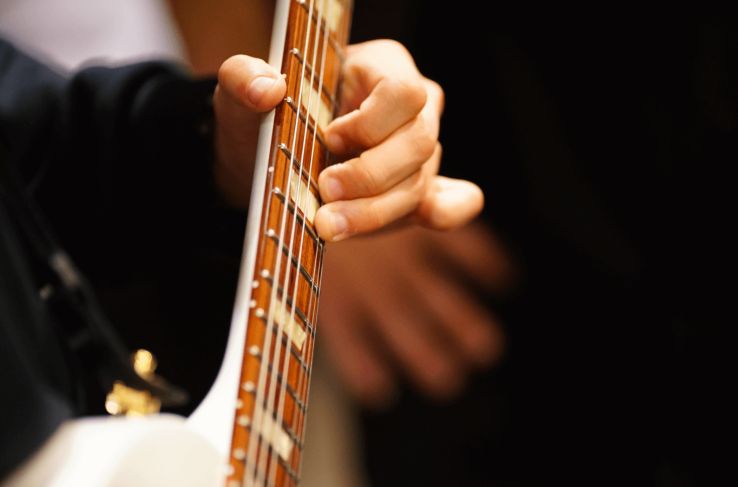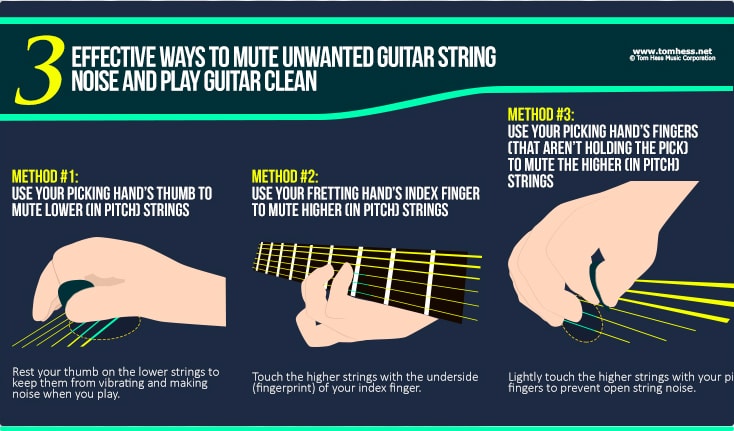Lead Guitar Phrasing Lesson – Play Guitar Licks That Make The Guitar Cry
by Tom Hess
Emotion To Any Guitar Lick

EMAIL TO GET ACCESS
By submitting your info, you agree to send it to Tom Hess Music Corporation who will process and use it according to their privacy policy.
Then memorize the most important word in all of guitar playing:
Lead guitar phrasing.
Ok, I cheated.
It’s actually 3 words.
But the most important word in the phrase “lead guitar phrasing” is still:
Phrasing.
Phrasing means: how you play the notes you play.
Emotion To Any Guitar Lick

EMAIL TO GET ACCESS
By submitting your info, you agree to send it to Tom Hess Music Corporation who will process and use it according to their privacy policy.
… lead guitar phrasing is all about the nuances you use to turn ordinary string bends into expressive guitar string bends that light up your guitar licks and guitar solos.
Want to learn an easy way to do this?
Check out this video and I’ll show you how to make the guitar cry:
Now that you know how to make your guitar cry with expressive guitar string bends and emotional lead guitar phrasing…
Here are a few more tips for making your lead guitar solos sound better:
The secret to expressive guitar string bends that make the guitar cry comes down to doing string bends the right way.
Here is how:
Wrap your thumb around the neck of the guitar to have full control over the string. The spot where your index finger connects to your palm is the pivot point that rotates the arm to achieve expressive guitar string bends.
It looks like this:

Question: “But Tom Hess, I'm used to doing string bends with my thumb behind the neck of the guitar and they sound ok. Is that bad?”
Answer: It’s better to bend strings with the thumb wrapped around the neck for 2 reasons. First: it’s much easier to apply vibrato to bent notes (which is a key skill if you want to make the guitar cry and play guitar licks and guitar solos with awesome lead guitar phrasing).
And second: you can more easily do more advanced variations of expressive guitar string bends, such as:
- Wide-interval bends (up to 2.5 steps for example).
- Or sliding chains of guitar string bends.
These techniques are advanced variations of basic guitar string bends.
They take a lot of control and finesse to play well. Control & finesse you develop from having your thump wrapped around the neck of the guitar, as described above.
Good news is:
Anyone can learn to play them – including you.
And when you do - every lick you play will drip with heart-piercing emotion.
Check out this advanced guitar string bends demonstration and I’ll teach you how to do these string bending variations:
Question: “Tom Hess, when I bend strings, I have a hard time keeping my bends in tune – making it hard to play expressive guitar string bends with good lead guitar phrasing. I'm trying to keep my thumb wrapped around the neck, but it’s not working. What can I do?”
Answer: There are 2 solutions to this lead guitar phrasing problem.
First, don’t play too fast. Put pauses between attempts to bend a string. Do the string bend and LISTEN to the sound. Ask yourself if the string bend is in tune, a little sharp or a little flat.
You cannot make the guitar cry with expressive guitar string bends and great lead guitar phrasing, unless you can do the above.
After you confirm how the string bend sounded – play it again, looking to either: make it sound in tune this time or repeat the perfect sound from the previous attempt.
That’s how you refine your ordinary, plain string bends and turn them into expressive guitar string bends that can make the guitar cry.
Another way to make your string bends consistently in tune is to play the note you are going to bend up to as an unbent note and then bend to it right afterward.
Like this: say you want to bend the B string from the 10th fret to the 12th fret. Play the 12th fret (as an unbent note) first. Get its sound into your ear.
Then do the bend (using the same analysis as described in the previous idea). This idea not only helps you make your string bends more consistent, but it also can help you play cool guitar licks with great lead guitar phrasing. (This way of bending strings is called a “re-articulation bend” and it’s one of the more expressive guitar string bends you can use in your guitar licks and guitar solos.)
Believe it or not, you can get virtually infinite lead guitar sustain in your playing.
And you can do it without shelling out cash for a sustainer, active pick ups, pedals, new amps, or even new strings.
Here is all you need:
- Your 2 hands,
- A stiff guitar pick (that doesn't flex when you hit the string)
- And an amp with its gain turned up all the way to 10.
(Oh, and you’d better have your guitar volume and “tone” knobs turned up to 10 too, but that goes without saying.)
Ready to start?
Watch this video & discover the secret to infinite lead guitar sustain:
Question: “Tom Hess, what if I want to spend some money on upgrading my guitar to have the best and most expressive lead guitar phrasing possible? Are there things I can buy to give me more sustain and help make the guitar cry when doing expressive guitar string bends in my guitar licks and guitar solos?”
Answer: 99.999% of what goes into your lead guitar phrasing and your ability to make the guitar cry comes from your hands – not your gear. So, you certainly don’t need to spend a penny to play guitar licks that are marinated with your emotions.
That said, if you are after the extra 0.001% and you have money to spend, here are some things you can buy to improve your guitar sustain (and lead guitar phrasing):
- A neck-through guitar (where the guitar body and the neck are carved from one piece of wood) vs. a guitar with a bolt-on neck.
- Active pick ups that run on batteries to compress the signal and make the note sustain longer.
Jumbo frets (install them into your guitar). These frets make it much easier to do string bends and (very slightly) increase sustain because the string doesn't rub against the guitar neck when you play expressive guitar string bends in your guitar licks and guitar solos.
It doesn't matter how fast you play guitar or how expressive your lead guitar phrasing is:
Sloppy string noise always makes you sound like an amateur (even if you are playing the most expressive guitar string bends when the noise happens).
 Create Awesome Rock Guitar Licks
Create Awesome Rock Guitar LicksLearn how to make any guitar lick you play sound absolutely amazing.
 How To Quickly Build Guitar Speed
How To Quickly Build Guitar SpeedLearn the secrets to building guitar speed by watching this free video.
 How To Fix Sloppy Guitar Playing
How To Fix Sloppy Guitar PlayingUse this muting technique to clean up your guitar playing right away.
That said, there are simple ways to block excess string noise from entering your guitar playing and play guitar licks perfectly cleanly during your guitar solos.
When you do – it becomes much easier to apply the expressive guitar string bends from this article and make the guitar cry.
Here are some ways to control sloppy string noise in your guitar licks and guitar solos:
Thumb Muting: As it sounds – rest your picking hand’s thumb on the lower (in pitch) guitar strings to keep them from vibrating. Then slide your thumb up and down the strings as you play guitar. This technique is supremely effective for muting string noise when you are performing expressive guitar string bends and playing guitar licks and guitar solos with emotional lead guitar phrasing.
Question: “But Tom Hess, I hear pinch harmonics when I do thumb muting every time I pick a note! I can’t seem to get a clear note to come out when playing expressive guitar string bends and I can’t make the guitar cry. What am I doing wrong?”
Answer: This is very likely caused by how you are holding the guitar pick. If you are holding your guitar pick on the side of the index finger, thumb muting becomes impossible.
The solution? Hold the guitar pick the same way you pick up a pen: between your fingerprint of the index finger and the thumb. This way the thumb naturally rests on the strings (without you having to get your hand into an awkward position).
More importantly: this makes it easy to play expressive guitar string bends with great lead guitar phrasing in your guitar licks and guitar solos. The result is: it becomes easy to make the guitar cry.
Here is the best way to hold your guitar pick:
Other effective string noise muting techniques include:
Muting with the underside of your index finger (of your fretting hand). This helps to mute the noise from the higher (in pitch) strings on your guitar as you practice guitar licks with expressive guitar string bends.
Muting the higher in pitch strings using the fingers not holding the pick (in your picking hand). This is another effective way to make your guitar licks and guitar solos perfectly clean (making it easier to play with emotional lead guitar phrasing).

Expressive lead guitar phrasing may be the most important phrase in all of guitar playing…
But “vibrato” is a close second in importance when it comes to your ability to make the guitar cry.
Question: “Tom Hess, what IS the best hand position for vibrato?”
Answer: Wrap your thumb over the neck of the guitar & use the web between your thumb and index finger as the pivot point.
That said:
Focus on the sound of your vibrato first – finger motions second.
Many lead guitar players do the opposite. They try to find the best hand position and pay little attention to the sound.
The result?
Sloppy, out of control vibrato that often sounds like a mosquito.
Here is how to avoid this problem and make any guitar melody sound great with vibrato:
Bonus vibrato tips (that help you make the guitar cry):
1. Practice delayed vibrato. That means: play a note and let it sustain with no vibrato. Then, after about 1 second – add vibrato. That is similar to how great singers do vibrato on their melodies and it’s a big part of expressive lead guitar phrasing.
You can also rearticulate the note (pick it again a second time) before applying vibrato.
2. Practice combining vibrato with expressive guitar string bends. This is the ultimate level of mastery when it comes to being able to make the guitar cry.
As you get better at doing individual elements of lead guitar phrasing…
… the next step towards being able to make the guitar cry is integrating these techniques together.
For example: take the expressive guitar string bends you learned in this article and apply them to guitar licks you already know… in combination with vibrato, slides, double stops, pinch harmonics, picking hand rakes, and legato.
Challenge yourself to practice a single guitar lick for 1 hour straight, where your only goal is to refine it. That means: play it with the best lead guitar phrasing you can (and incorporate as many of the expressive guitar string bends into your ideas as you can).
That is the kind of practice that leads you to be able to make the guitar cry.
Watch this video to see a demonstration:
Now that you know how to make the guitar cry using expressive guitar string bends in your guitar licks and guitar solos, the next step is to learn even more ways to add fire and expression to your lead guitar playing.
I show you how in my free eGuide “How To Add Fire & Emotion To Your Guitar Licks, Even If You Can’t Play Guitar Fast Yet”. Grab your copy today and discover the lead guitar-playing secrets most guitar players will never know.
 About Tom Hess: Tom Hess is a guitar teacher, music career mentor and guitar teacher trainer. He teaches rock guitar lessons online to students from all over the world and conducts instructional live guitar training events attended by musicians from over 50 countries.
About Tom Hess: Tom Hess is a guitar teacher, music career mentor and guitar teacher trainer. He teaches rock guitar lessons online to students from all over the world and conducts instructional live guitar training events attended by musicians from over 50 countries.
 | Forward this article to your friends |

